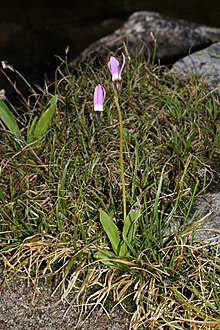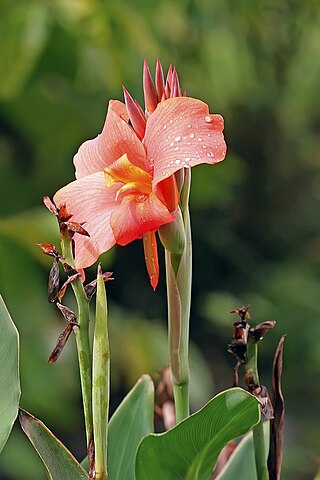
Canna or canna lily is the only genus of flowering plants in the family Cannaceae, consisting of 10 species. Cannas are not true lilies, but have been assigned by the APG II system of 2003 to the order Zingiberales in the monocot clade Commelinids, together with their closest relatives, the gingers, spiral gingers, bananas, arrowroots, heliconias, and birds of paradise.

Phalaenopsis, also known as moth orchids, is a genus of about seventy species of plants in the family Orchidaceae. Orchids in this genus are monopodial epiphytes or lithophytes with long, coarse roots, short, leafy stems and long-lasting, flat flowers arranged in a flowering stem that often branches near the end. Orchids in this genus are native to India, Taiwan, China, Southeast Asia, New Guinea and Australia with the majority in Indonesia and the Philippines.
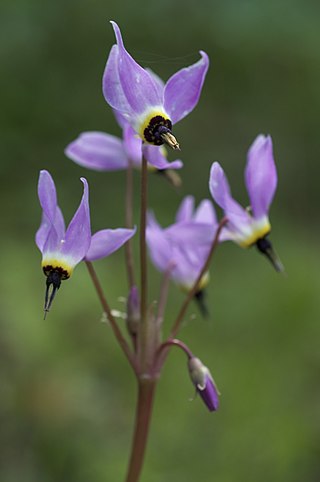
Primula hendersonii is a species of flowering plant in the family Primulaceae, native to western North America, from California north to southern British Columbia and Idaho. Common names include broad-leaved shooting star, Henderson's shooting star, mosquito bills, and sailor caps.

Buzz pollination or sonication is a technique used by some bees, such as solitary bees to release pollen which is more or less firmly held by the anthers. The anthers of buzz-pollinated plant species are typically tubular, with an opening at only one end, and the pollen inside is smooth-grained and firmly attached. With self-fertile plants such as tomatoes, wind may be sufficient to shake loose the pollen through pores in the anther and accomplish pollination. Visits by bees may also shake loose some pollen, but more efficient pollination of those plants is accomplished by a few insect species who specialize in sonication or buzz pollination.

Primula vulgaris, the common primrose, is a species of flowering plant in the family Primulaceae, native to western and southern Europe, northwest Africa, and parts of southwest Asia. The common name is primrose, or occasionally common primrose or English primrose to distinguish it from other Primula species also called primroses. None of these are closely related to the evening primroses.

Paeonia brownii is a low to medium height, herbaceous perennial flowering plant in the family Paeoniaceae. It has compound, steely-gray, somewhat fleshy leaves and small drooping maroon flowers. Its vernacular name is Brown's peony, native peony or western peony. It is native to the western United States and usually grows at altitude, often as undergrowth in part-shade. The fleshy roots store food to carry the plant through the dry summers and produce new leaves and flowers the following spring.

A flower, sometimes known as a bloom or blossom, is the reproductive structure found in flowering plants. Flowers produce gametophytes, which in flowering plants consist of a few haploid cells which produce gametes. The "male" gametophyte, which produces non-motile sperm, is enclosed within pollen grains; the "female" gametophyte is contained within the ovule. When pollen from the anther of a flower is deposited on the stigma, this is called pollination. Some flowers may self-pollinate, producing seed using pollen from the same flower or a different flower of the same plant, but others have mechanisms to prevent self-pollination and rely on cross-pollination, when pollen is transferred from the anther of one flower to the stigma of another flower on a different individual of the same species.

Primula scotica, commonly known as Scottish primrose, is a species of flowering plant in the family, Primulaceae, the primroses and their relatives. It was first described by James Smith, and is endemic to the north coast of Scotland.

The Proteaceae form a family of flowering plants predominantly distributed in the Southern Hemisphere. The family comprises 83 genera with about 1,660 known species. Australia and South Africa have the greatest concentrations of diversity. Together with the Platanaceae and Nelumbonaceae, they make up the order Proteales. Well-known genera include Protea, Banksia, Embothrium, Grevillea, Hakea and Macadamia. Species such as the New South Wales waratah, king protea, and various species of Banksia, Grevillea, and Leucadendron are popular cut flowers. The nuts of Macadamia integrifolia are widely grown commercially and consumed, as are those of Gevuina avellana on a smaller scale.

Draba verna, common whitlowgrass, is a species of plant in the cabbage family. It is a small spring-flowering annual which is widely dispersed around the world, and which is found on walls, pavements and patches of bare ground. It has a complex taxonomy which is not yet fully elucidated.

Primula meadia, the shooting star or eastern shooting star, is a species of flowering plant in the primrose family Primulaceae. It is native to the eastern United States and Canada, spanning north from Manitoba and New York, south to Texas and Florida.

Primula pauciflora, the pretty shooting star, few-flowered shooting star, dark throat shooting star or prairie shooting star, is a species of flowering plant in the primula family Primulaceae. It is a widespread and very variable species, native to western North America, from Subarctic America to Mexico, often in xeric and desert habitats. It is found in the Great Basin Deserts and Mojave Desert. Its synonyms include Dodecatheon pauciflorum and Dodecatheon pulchellum.
This page provides a glossary of plant morphology. Botanists and other biologists who study plant morphology use a number of different terms to classify and identify plant organs and parts that can be observed using no more than a handheld magnifying lens. This page provides help in understanding the numerous other pages describing plants by their various taxa. The accompanying page—Plant morphology—provides an overview of the science of the external form of plants. There is also an alphabetical list: Glossary of botanical terms. In contrast, this page deals with botanical terms in a systematic manner, with some illustrations, and organized by plant anatomy and function in plant physiology.

Primula conjugens, synonym Dodecatheon conjugens, is a species of flowering perennial plant in the primrose family, known by the common name Bonneville shooting star.
This glossary of botanical terms is a list of definitions of terms and concepts relevant to botany and plants in general. Terms of plant morphology are included here as well as at the more specific Glossary of plant morphology and Glossary of leaf morphology. For other related terms, see Glossary of phytopathology, Glossary of lichen terms, and List of Latin and Greek words commonly used in systematic names.

Persoonia lanceolata, commonly known as lance-leaf geebung, is a shrub native to New South Wales in eastern Australia. It reaches 3 m (10 ft) in height and has smooth grey bark and bright green foliage. Its small yellow flowers grow on racemes and appear in the austral summer and autumn, followed by green fleshy fruits which ripen the following spring. Within the genus Persoonia, P. lanceolata belongs to the lanceolata group of 58 closely related species. It interbreeds with several other species found in its range.
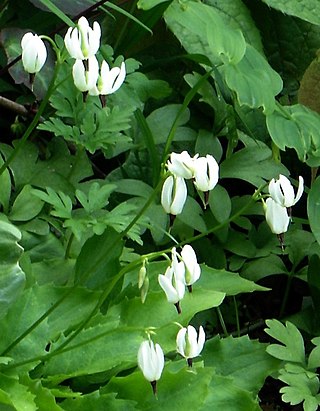
Primula latiloba, synonyms Dodecatheon dentatum and Dodecatheon latilobum, is a species of flowering plant in the family Primulaceae, known by the common names white shooting star and toothed American cowslip.
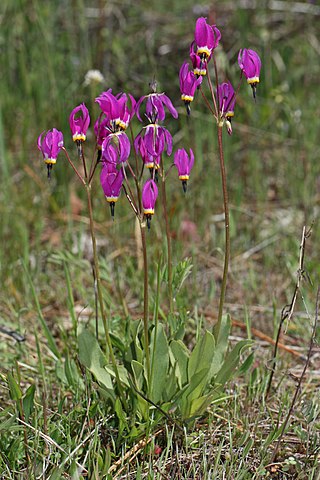
Primula poetica, synonym Dodecatheon poeticum, is commonly known as the poet's shooting star or the narcissus shooting star. P. poetica is a species of the genus Primula placed in section Dodecatheon. It is native to the states of Oregon and Washington in western North America. The section contains herbaceous flowering plants and is also a part of the primrose family Primulaceae. This plant has basal clumps of leaves and drooping flowers that occur at the apex of tall stems that rise from where the leaves join.

Rhexia mariana is a species of flowering plant in the Melastomataceae family known by the common names pale meadow beauty or Maryland meadowbeauty. It is native to the eastern and lower midwestern United States.

Primula frenchii, French's shootingstar, is a species of flowering plant in the family Primulaceae. It is native to the central and southern United States, in southern Illinois, Indiana, Kentucky, Arkansas, and Alabama. It grows in moist, shady areas such as ledges near streams and under sandstone cliffs.

